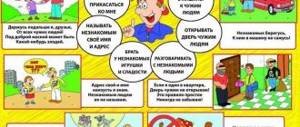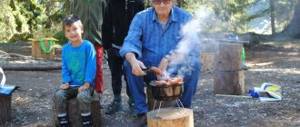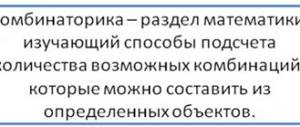General rules of table etiquette
Dining etiquette varies depending on the country, the purpose of the meeting (formal dinner or friendly gatherings), and the place chosen for the feast. However, there are general rules of conduct that must be observed in any situation. This will give you a reputation as a well-mannered and worthy person.
These rules include the following:
- You can't talk with your mouth full.
- If some food is far away, you don’t need to reach across the table for it. All you have to do is ask your neighbor to pass it closer.
- You cannot take with your spoon from a common dish.
- If a device falls, do not reach under the table for it. All you have to do is ask for it to be replaced.
- While eating, it is not permissible to slurp, sneeze, blow your nose, etc.
- You can't put your elbows on the table.
- Food is served in small portions, eaten calmly, without rushing.
Handling cutlery
Each dish can be eaten with a separate set of cutlery. Steaks, open sandwiches, cold appetizers are cut with a knife and fork. Take hot food from the cocotte maker with a teaspoon. Restaurants serve separate utensils for fruits, desserts, and exotic foods (lobster, oysters, snails, mussels, etc.). Some dishes (pizza, closed sandwiches, pies) can be eaten with your hands.
According to traditional European etiquette, the knife should always be held in the right hand and the fork in the left. They should not be released while eating. The handles of the devices should be grasped with the entire palm - this reduces the risk of dropping them. If the food does not require cutting, you can hold the fork in your right hand, scooping the dish with it like a spatula.
The device is positioned with its teeth facing upward, and the handle is held between the thumb and forefinger.
American etiquette is less strict. He allows you to take a knife only when necessary, and transfer the fork to your right hand.
Other rules for handling devices:
- You can only cut food towards yourself. This will help avoid accidents.
- A table knife should only be used for cutting food and holding pieces of food on the fork. It is forbidden to eat from it.
- When eating hot appetizers and meat dishes, you should not immediately cut them into small pieces. This is not only indecent, but also causes the food to cool down, causing it to lose its flavor.
- If you drop a cutlery, do not reach under the table for it. Instead, you need to politely ask the host of the feast (or the waiter in the restaurant) to bring a new one.
- If there is a need to pass the device to a neighbor, this should be done with the blunt side forward, holding the middle of the handle.
- Soups are scooped with a spoon from yourself. This will help protect against splashes.
- A teaspoon or coffee spoon can only be used to stir the drink. It is forbidden to leave it in the cup.
- Mix drinks slowly and carefully. Do not hit the spoon on the edge of the cup.
- Used cutlery must not be placed on the table. After finishing the meal, they are left on the edge of the plate.
Even if a dish is traditionally eaten with your hands (baked goods, whole fruits and vegetables, etc.), you can pass it to a neighbor using special tweezers.
Placement on the table
The cutlery on the table is arranged in accordance with the order in which the dishes are served. Those that will be used first are placed closer to the edge, gradually moving them closer to the plate. Such serving will help guests better navigate and make the meal more convenient for them. Place a napkin under each device - they should not touch the table.
To correctly position various knives, spoons and forks, you need to know their purpose:
- A tablespoon is the largest. It is intended for first courses, so it is placed on the right edge of the plate.
- A dessert spoon is smaller than a tablespoon and has a more elegant shape. It is needed for eating desserts that do not require cutting - jellies, mousses, puddings, whipped cream.
- The ice cream spoon is not placed on the table when setting the table, but is served separately along with a vase or bowl.
- A cocktail spoon with a narrow, long handle is served along with the drink. It serves as decoration and cannot be removed from the glass.
- Tea and coffee spoons are served on a saucer along with the corresponding drinks.
- A table knife and fork are intended for main courses and main courses, which is why they are placed closer to the plate than spoons for first courses. According to the rules of etiquette, the knife must be held in the right hand, and the fork in the left, therefore, when serving, they are placed on the corresponding sides (for left-handed people - vice versa).
- The placement of fish, snack, fruit, dessert knives and forks depends on the order in which the dishes are served.
- Auxiliary cutlery (for example, tweezers for opening snails or oysters) is served along with the food for which they are intended.
When serving food, the knife blades should always point towards the plate.
Special gestures and signs
Restaurant culture has developed a special language of knives and forks, with which you can express your intentions to the waiter.
Some of his gestures:
- cutlery lies parallel to each other on the right side of the plate - the meal is over;
- the edges of the knife and fork touch the plate, but the handles lie on the table - pause;
- the fork lies on top of the knife and perpendicular to it with the teeth up - waiting for more;
- cutlery lies crosswise - waiting for the next dish;
- cutlery lies parallel to each other with handles down - thanks to the cook;
- the knife and fork are crossed with their teeth - you didn’t like the food;
- cutlery lies on the edges of the plate with the handles up - the guest demands a plaintive book;
- the blade of the knife lies between the outer tines of the fork - the visitor is satisfied with everything and is ready to become a regular customer of the restaurant.
Official reception, banquet
An official reception is not just a feast. Important issues are resolved here, people find future partners and employees. And how much a person knows and observes banquet etiquette determines how others will think about him.
Here are a few simple rules of table etiquette that you need to know and follow:
- You can't put your elbows on the table.
- When eating, do not lean towards the plate, but bring a spoon or fork to your mouth.
- You should not blow on hot food.
- The bread is broken off from a piece little by little. Do not dip a piece of bread into the sauce.
- Pasta, noodles, pudding, jelly, fish, and cutlets are eaten with a fork.
- Before you wash down your food, you need to chew and wipe your lips with a napkin.
- Before pouring yourself a drink, offer it to those sitting next to you.
- You should not leave the banquet before it ends. If there is a good reason, you can leave the feast during breaks between speeches.
- Strangers should introduce themselves to each other.
- Clothes must be formal: for men a tuxedo or a formal dark suit, for women - a classic dress.
- After eating, the fork and spoon are placed parallel on the plate.
- At an official reception or banquet, discussion of business begins after the meal is over.
Rules for table manners in kindergarten
The issue of organizing children's nutrition in a preschool educational institution is an important task that the kindergarten team solves in its multifaceted approach. Proper healthy nutrition for preschoolers is accompanied by its proper organization. For young children, everything is like an adult: a set table that is aesthetically attractive, and, of course, the rules of behavior for children at the table. This is easy to understand; in a group of 20 to 35 people, a dinner organized without rules of behavior and discipline would turn into chaos with a high degree of risk to the health (life) of children. But this doesn't happen. The study of rules of behavior and norms of etiquette in preschool educational institutions does not occur from case to case, but in the process of all regime moments. Eating is the most important moment; there is a special approach to it. Both parents and children themselves understand this.
The task of instilling table manners among preschoolers is clearly formulated in preschool educational programs, taking into account the age characteristics of the groups.
| Age group | Tasks for developing a culture of nutrition and behavior at the table (hygienic skills) |
| 1st junior group (2-3 years) | 1. Strengthen the ability to wash your hands, face, dry with a towel |
| 2. Chew your food thoroughly | |
| 3. Hold the spoon in your right hand (exception for left-handers) | |
| 4. Use a napkin | |
| 5. Give thanks after finishing a meal (say “thank you”) | |
| 6. Know short poems and nursery rhymes about food | |
| 2nd junior group (3-4 years) | 1. Hygiene skills (wash your face yourself with soap, dry yourself with a towel) |
| 2. The ability not to crumble bread | |
| 3. Use cutlery | |
| 4. Chew food with your mouth closed | |
| 5. Do not talk while chewing food | |
| 6. Behave calmly and say thank you after finishing a meal | |
| Middle group (4-5 years old) | 1. Take food little by little and chew well |
| 2. Get acquainted with cutlery (knife, fork) | |
| 3. Eat quietly, use a napkin | |
| 4. Develop a positive attitude towards the rules and culture of food | |
| 5. Understanding that others approve of “correct” behavior at the table, and condemn the manifestation of sloppiness and bad behavior | |
| Senior group (5-6 years old) | 1. Strengthen the ability to use cutlery (fork, knife, spoon) |
| 2. Eat quietly | |
| 3. Maintain correct posture while eating | |
| 4. After eating, move your chair in and thank the adults. | |
| 5. Help with table setting | |
| Preparatory group 6-7 years old) | 1. Consolidate all previously acquired skills and abilities |
| 2. Sit in the correct position, maintaining posture, without putting your elbows on the table | |
| 3. Use a fork and knife correctly | |
| 4. Using a napkin during and after meals | |
| 5. Participate in setting the table, clearing dishes after meals | |
| 6. Thank adults |
My child is behaving badly, what should I do?
Celebration in a cafe, restaurant
If you are invited to a restaurant or cafe, be sure to review the rules of table etiquette. Surely, the owners will not want to invite someone who does not know how to behave at the table another time.
Here are the basic rules that everyone should know:
- You need to sit straight at the table, without leaning on the back of the chair or hanging over the plate.
- The bag or briefcase is placed near the chair.
- You can start eating when each guest's order has been served.
- They don’t blow on hot food, but wait until it cools down.
- It is not polite to talk on the phone at the table. If you need to answer an urgent call, you should excuse yourself and leave.
- The cuts from the common plate are placed on your own.
- If you drop a device on the floor, you need to ask the waiter to replace it.
- Comments about the quality of food or service are made to the head waiter. It is rude to express complaints to the waiter during lunch.
- Naturally, you cannot speak with your mouth full and slurp. It's rude to talk on the phone at the table. Don't worry if you drop cutlery on the floor or accidentally break a glass.
Dining etiquette at home
The rules of home dining etiquette are simpler. But this does not mean that you can do whatever you want at the table. Basic rules of etiquette must be observed both at home and when visiting friends and relatives.
- It is necessary to start eating after a signal from the owner of the house.
- You are not supposed to talk with your mouth full.
- The younger ones take food after the older ones.
- It’s not nice to put your spoon into a shared plate.
- The bread is not cut with a knife or bitten, but small pieces are broken off and placed in the mouth.
- Watching TV or reading the newspaper while eating is a bad habit.
- It's not nice to make comments out loud about the quality of food.
- You cannot do toileting at the table (apply makeup, do manicures, etc.).
Rules for children's behavior at the table
You need to start teaching your child about table etiquette from a very early age. At first it may seem like a game. Subsequently, the acquired skills will be useful in adult life.
The child should know that:
- At the table you cannot rock your chair or play with food or cutlery.
- You cannot reach across the table for the desired dish, but you need to ask for it to be passed.
- You need to eat silently.
- While eating, do not play with toys or watch cartoons.
- You need to put on the plate as much as you can eat (this applies to older children who put food on the plate themselves).
- You are not supposed to leave the table until dinner is over. If a child needs to leave early, he should quietly ask permission from elders.
Additional table manners: etiquette for children
When kids know that they eat food using cutlery, understand the basic rules of etiquette and put them into practice, they are ready to learn new information. Impeccable manners will help you develop the following recommendations:
- Ban on playing with food
Table etiquette for children does not allow playing with food. Even if we are talking about a matinee or children's name days, the little ones present at the meal should not smear ketchup on the plate, showing their artistic talent, throw bread and juggle fruit. Games in polite society are not played at the table, and children should get used to this rule from childhood.
- Showing gratitude
Children should learn to be grateful for the food that their grandparents or parents lovingly prepared for them. Therefore, it is important to teach your child to say thank you after lunch. He can also say what dish he liked, etc.
- Optimal portion: how to eat food from shared plates
There are always dishes on common plates on the table - these can be salads, appetizers, sauces, etc. Children should know that they need to be placed on their plate in portions, using cutlery placed on a common dish. It is indecent to use your own fork or spoon for these purposes.
Table setting, use of cutlery
A person unfamiliar with the rules of table setting may be horrified by the abundance of cutlery near the plate. It's not surprising to feel a little confused remembering the purpose of each fork and spoon. Proper use of cutlery and beautiful, aesthetic eating is an art. There is even a cutlery language! You can also familiarize yourself with wine and tea etiquette separately.
Studying the rules of table etiquette will help you understand this science and not get into trouble. You need to know the rules for using a napkin: place a cloth napkin on your knees, do not tie it around your neck. After the end of the feast, you should place the napkin on the edge of the table near your plate.
The main advice in case of imperfect knowledge of table etiquette is to remain calm and casual.
Table conversation and manners
First, you need to know the list of topics that cannot be discussed at the table. It is unacceptable to discuss diseases, anatomy, intimate issues, income, troubles at work, religion and politics.
In addition, there are general rules for table conversation:
- At a common table they talk about what is interesting and understandable to everyone present.
- You cannot speak only to a limited circle of people, ignoring the rest.
- You should not talk for too long, you should give the floor to others.
- It is not customary to ask your interlocutor about his age and position in society.
- At large dinners, the hostess starts the conversation, and the guests follow the suggested topic.
According to modern dining etiquette, excessive mannerisms look pretentious and inappropriate, for example, a protruding little finger. A favorable attitude towards waiters also speaks about your culture of behavior.
Features in different countries
In most European countries, French or English etiquette is common. But a number of countries have their own customs, sometimes very unusual for foreigners.
Japan
Here, slurping at the table is not only possible, but also necessary. After all, this is how guests show that they really like the food. But sticks stuck into food will cause horror among others. After all, they only do this at wakes. Another feature of Japanese etiquette is that soup is drunk from a bowl over the edge.
Germany
Germans will never come to someone else's house without a gift. And belching at the table is considered the norm among them. The saying “What is natural is not ugly” is exactly about them.
Korea
If you find yourself having lunch with Koreans, watch the pace of your food intake. Finishing your meal before everyone else means showing the hosts that you were offered too small a portion. Also in this country, subordination is strictly observed: those older in age or position in society sit first.
Italy
Asking for salt in an Italian house means causing a terrible offense to the owners. Italians are lovers of long gatherings. So, when going to visit, expect to spend about 5 hours there.
Why do we need table rules?
Compliance with rules and etiquette at the table is not the prerogative of a certain social group of people. It has nothing to do with the level of income or social status of the family. “We are from simple people, from workers. Why do we need all these tablecloths, napkins, forks and knives? Why does my child need all this? “Kindergarten teachers sometimes hear something similar. It is important to understand that the culture of nutrition and behavior is not whims, not the desire to “show off” in front of others. The fact is that following certain rules of etiquette at the table makes sense and has specific benefits for children. Let's look at some of them:
- Washing your hands before eating protects the body from pathogenic bacteria entering with food;
- Setting the table using a clean tablecloth and disposable napkins protects food from coming into contact with the surface of the dining table;
- The requirement to “not fidget” and not talk while eating is to prevent serious incidents at the table (the child may choke);
- The request to “take your time,” sit up straight and chew your food thoroughly is nothing more than helping the stomach digest what you eat quickly and easily;
- A napkin placed on your knee (or chest) will protect your clothes from getting dirty.
Rules for safe behavior in spring for children
I would especially like to highlight the use of special cutlery during meals. Many still believe that this is nothing more than deliberate behavior of the upper class, in order to show their skills and knowledge in this area. It's not like that at all. To use devices skillfully, you do not need to be a representative of a certain group. The use of devices is not intended to exhaust, but to facilitate the actions of the eater . It is much more convenient to eat meat by cutting it into pieces (rather than biting whole with a fork), it is convenient to cut fish with a special fork, and eat dessert with a small spoon or fork. It's true?









